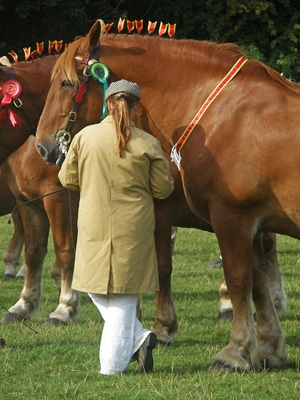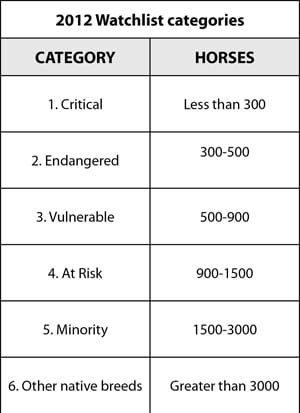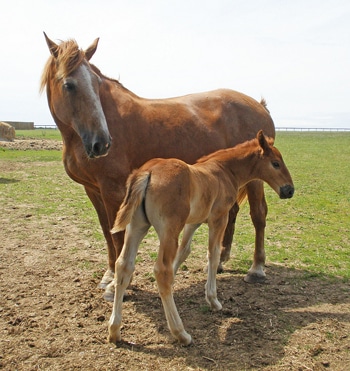For hundreds of years, the Suffolk Punch draft horse has been used by farmers to till fields across Great Britain. Now, Britain’s oldest native breed is on the brink of extinction.
The breed was developed in the early 16th century, and still looks similar to its foundation stock. The Suffolk Punch was developed for farm work, and gained popularity until tractors took over on farms. It was then the breed fell out of favour, and now it’s almost disappeared completely.
1. To get a sense of how old this breed is, in what year did the 16th century start?

3. How many decades long is a century?
All Suffolks are chestnut in colour, one of seven shades between gold and liver. White markings are rarely seen. The horses stand 64-68 inches (162.56 to 172.72 cm) and weigh an average of 1,800 pounds (816.5 kg).
4. What is the height range of the Suffolk Punch breed in hands?
The Suffolk Punch population was at its highest during the Second World War, from 1939 to 1946, with the most new registrations in the Suffolk Horse Society stud books; over 6,000 horses registered.
After this period, the breed declined rapidly to the low point in 1966 when there were only nine Suffolk foals registered! Concerned people stepped in to try and save the breed. According to the Society, today there are around 500 horses registered in the UK.
5. Approximately how many fewer horses are registered with the Society today than when the breed was at its peak? Write your answer in word form.

The breeds are placed into appropriate categories based on species and the total number of registered breeding females in the United Kingdom.
The Rare Breeds Survival Trust is another organization involved in securing the future of rare and native breeds of farm livestock in the UK. They keep a Watchlist showing population categories for horse and pony populations (UK only, not worldwide). The numbers showing reflect the registered number of breeding females.
The Trust announced that there has been a small increase in registered breeding mares from 138 in 2012 to 170 in 2015.
By 2016, there were approximately 300 Suffolk Punches in the UK with 30 to 40 pure bred foals being born annually.
6. How many more registered breeding mares were there in 2015 than in 2012?
7. In which category would you put Suffolk Punch horses?
8. If 20 pure bred fillies are born annually in the UK, how many years will it take for this breed to move up to Category 2, Endangered?
Along with less need for working horses on farms, another reason the Suffolk Punch horse is endangered is because not enough females are being born.
According to recent figures published by the Trust, just 33 fillies were born between 2014-16 – less than half the number of males during the same period.
9. Express the relationship between the number of fillies born and the number of colts born in a math expression.
10. Estimate the number of male foals born during the same period.
Claire Barber, from the trust, said: “They’re one of the few breeds showing small increases in their population, which is very, very positive.” This is good news. It will be interesting to watch as this beautiful, powerful breed makes a comeback!
Watch as the president of the Suffolk Horse Society talks about these rare horses.
1. To get a sense of how old this breed is, in what year did the 16th century start?
Answer: 1501
2. In what year did the 16th century end?
Answer: 1600
3. How many decades long is a century?
Answer: 10. There are ten years in one decade and one hundred years in a century. 100 ÷ 10 = 10.
4. What is the height range of the Suffolk Punch breed in hands?
Customary Units Answer:
64 inches ÷ 4 inches/hand = 16 hands.
68 ÷ 4 inches/hand = 17 hands. Suffolk Punch horses range in height from 16 to 17 hands.
Metric Answer:
162.56 cm ÷ 10.2 cm/hand = 15.94 hands. Rounds to 16 hands.
172.72 ÷ 10.2 cm/hand = 16.93. Rounds to 17 hands. Suffolk Punch horses range in height from 16 to 17 hands.
5. Approximately how many fewer horses are registered with the Society today than when the breed was at its peak? Write your answer in word form.
Answer: 6,000 − 500 = 5500. There are five thousand five hundred fewer Suffolk Punch horses today.
6. How many more registered breeding mares were there in 2015 than in 2012?
Answer: 170 − 138 = 32. There were 32 more registered breeding mares in the UK.
7. In which category would you put Suffolk Punch horses?
Answer: Critical. 170 < 300. There were only 170 registered breeding mares in 2015.
8. If 20 pure bred fillies are born annually in the UK, how many years will it take for this breed to move up to Category 2, Endangered?
Answer:
Step 1: 300 mares (minimum needed for category 2) − 170 mares (breeding mares in 2015) = 130 mares.
Step 2: 130 mares ÷ 20 (number of fillies born per year) = 6.5.
It would take approximately 6.5 years.
9. Express the relationship between the number of fillies born and the number of colts born in a math expression.
Answer: We are told that 33 fillies were born. We’re also told that number was less than half the number of colts born. The unknown is the number of colts. I chose C to represent this unknown.
33 < 1/2 C
10. Estimate the number of male foals born during the same period.
Answer: There are different strategies you can use to arrive at an estimate. One is guess and check.
Let’s give that a try.
Guess 1: 60 = C. Half of 60 is 30. 30 is < 33; so we know that 60 is too low a number.
Guess 2: 64 = C. Half of 64 is 32. 32 is < 33; so we know that 64 is also too low a number. Guess 3: 66 = C. Half of 66 is 33. 33 = 33; 66 is too low a number. Guess 4: 68 = C. Half of 68 is 34. 34 is > 33; so 68 meets the criteria.
Approximately 68 colts were born during the same period.
Did you use a different strategy to estimate?
Common Core:
4.OA.A – Use the four operations with whole numbers to solve problems
4.OA.A.3 – Multi-step word problems
5.OA.A – Write and interpret numerical expressions.
6.EE.A – Apply and extend previous understandings of arithmetic to algebraic expressions.
6.NS.B.2 – Add, subtract, multiply, or divide two whole numbers: word problems
Photos:
Suffolk Punch by Rictor Norton & David Allen; CC BY 2.0
The Suffolk Horse Society Spectacular 2016 by Amanda Slater; CC BY-SA 2.0
Suffolk Mare and foal by Amanda Slater; CC BY-SA 2.0









Here’s an interesting article about a day in the life of a Suffolk Punch owner: http://www.eadt.co.uk/ea-life/a-day-in-the-life-of-a-suffolk-punch-owner-caring-for-our-precious-county-horse-is-not-as-difficult-as-you-might-imagine-1-5095775